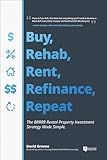Best 1031 Exchange Tips to Buy in December 2025

Buy, Rehab, Rent, Refinance, Repeat: The BRRRR Rental Property Investment Strategy Made Simple



The Book on Rental Property Investing: How to Create Wealth With Intelligent Buy and Hold Real Estate Investing (BiggerPockets Rental Kit, 2)



The Millionaire Real Estate Investor
- UNLOCK INVESTMENT POTENTIAL WITH EXPERT REAL ESTATE INSIGHTS.
- MAXIMIZE PROFITS THROUGH STRATEGIC MARKET ANALYSIS TECHNIQUES.
- LEVERAGE NETWORKING OPPORTUNITIES FOR LUCRATIVE DEALS AND PARTNERSHIPS.



The Book on Investing In Real Estate with No (and Low) Money Down: Creative Strategies for Investing in Real Estate Using Other People's Money (BiggerPockets Rental Kit, 1)



The ABCs of Real Estate Investing: The Secrets of Finding Hidden Profits Most Investors Miss
- COMPREHENSIVE GUIDE FOR BEGINNER AND SEASONED INVESTORS ALIKE.
- STEP-BY-STEP STRATEGIES TO MAXIMIZE PROPERTY INVESTMENT RETURNS.
- EXPERT INSIGHTS ON MARKET TRENDS AND INVESTMENT OPPORTUNITIES.



How to Invest in Real Estate: The Ultimate Beginner's Guide to Getting Started


A 1031 exchange, also known as a like-kind exchange, is a provision in the United States tax code that allows real estate investors to defer capital gains taxes on the sale of investment properties if they reinvest the proceeds into another investment property. It gets its name from Section 1031 of the Internal Revenue Code.
Here's how it works:
- Qualifying properties: To be eligible for a 1031 exchange, both the property being sold (relinquished property) and the property being acquired (replacement property) must be held for investment or business purposes. Personal residences or properties primarily held for personal use do not qualify.
- Timing: The IRS imposes strict timelines that must be followed. Within 45 days of selling the relinquished property, the investor must identify potential replacement properties. The identification must be done in writing, signed, and delivered to a third party involved in the exchange, such as a qualified intermediary.
- Replacement property acquisition: The investor has 180 days from the sale of the relinquished property to close on the purchase of the replacement property. It can be any type of real estate as long as it qualifies and is equal or higher in value to the sold property.
- Qualified Intermediary: It is essential to use a qualified intermediary (QI) during a 1031 exchange. The QI holds the funds from the sale of the relinquished property and then uses them to purchase the replacement property, ensuring the investor doesn't have access to the money during the exchange period. This helps to maintain the tax-deferred status.
- Tax deferral: By completing a 1031 exchange, an investor can defer paying capital gains taxes on the sale of the relinquished property. However, it's important to note that the taxes are deferred, not permanently eliminated. If the investor eventually sells the replacement property without initiating another 1031 exchange, the deferred taxes become due.
- Value and debt requirements: To fully defer taxes, the investor must reinvest all of the net proceeds from the sale of the relinquished property into the replacement property. Additionally, the replacement property must have equal or greater value and debt compared to the relinquished property.
Overall, a 1031 exchange provides real estate investors with a tax-efficient strategy to preserve capital and grow their real estate portfolios. It allows them to defer taxes and leverage the proceeds from a sold property into a new investment, ultimately maximizing their potential for long-term financial success.
How does the 45-day identification period work in a 1031 exchange?
In a 1031 exchange, the 45-day identification period refers to the timeframe in which a taxpayer must identify potential replacement properties after selling their existing investment property. Here's how it works:
- Start Date: The identification period begins on the day the taxpayer transfers the relinquished property (i.e., the investment property they sold). This is typically the closing date of the sale.
- 45-Day Timeline: The taxpayer has exactly 45 calendar days from the start date to identify potential replacement properties. Weekends and holidays are included in the count, and the period cannot be extended, even if the 45th day falls on a weekend or holiday.
- Identification Rules: During this period, the taxpayer must formally identify the replacement properties in writing and deliver the identification to a qualified intermediary, which is a third-party facilitator responsible for handling the exchange process. The written identification should provide a clear description of the properties, ensuring they meet the identification requirements.
- Identification Limits: Under the "3-property rule," the taxpayer can identify up to three properties, regardless of their value. Alternatively, they can opt for the "200% rule" to identify more properties, as long as the total fair market value of all the identified properties does not exceed 200% of the relinquished property's sale price. Lastly, the "95% exception" allows the taxpayer to identify any number of properties, as long as they acquire at least 95% of their total value.
- Flexibility in Identification: The taxpayer has some flexibility in changing their identification within the 45-day period. They can substitute identified properties with others by submitting a new written identification to the qualified intermediary before the deadline. However, once the 45-day period expires, the identification becomes binding.
It's important to note that meeting the 45-day identification period is crucial for a successful 1031 exchange. If a taxpayer fails to identify replacement properties within this timeframe, they risk the exchange being considered invalid, and they may be subject to paying capital gains taxes on the sale of their relinquished property. Thus, proper planning and consultation with tax and real estate professionals are highly recommended.
Can a primary residence be used in a 1031 exchange?
No, a primary residence cannot be used in a 1031 exchange. The purpose of a 1031 exchange is to defer capital gains tax on investment properties by exchanging one investment property for another. Primary residences are not eligible for this tax deferral benefit. However, there are other tax benefits available for primary residences, such as the capital gains exclusion for the sale of a primary residence. It is always recommended to consult with a tax advisor for personalized advice regarding specific situations.
How does the boot rule apply to a 1031 exchange?
The boot rule refers to a situation that can occur in a 1031 exchange, which is a tax strategy used to defer capital gains taxes when selling and buying like-kind properties. In a 1031 exchange, if the value of the replacement property acquired is less than the value of the relinquished property sold, there may be a boot.
The boot can be either cash boot or mortgage boot. Cash boot arises when the taxpayer receives cash or non-like-kind property as part of the exchange. Mortgage boot occurs when the taxpayer assumes less debt on the replacement property compared to the relinquished property.
If a boot is present in a 1031 exchange, it is not completely tax-free, and the taxpayer may have to pay taxes on the boot amount. The boot is treated as a gain realized from the exchange and is subject to capital gains tax.
It's important to note that the primary goal of a 1031 exchange is to defer capital gains taxes, so minimizing or avoiding the presence of a boot is typically the desired outcome. Taxpayers may consult with qualified intermediaries or tax professionals to structure the exchange in a way that minimizes the boot and maximizes tax benefits.
What steps should be taken to comply with the IRS regulations during a 1031 exchange?
Complying with IRS regulations during a 1031 exchange involves following a specific set of steps. Here are the key actions to be taken:
- Identify the Replacement Property: Within 45 days of selling the relinquished property, the taxpayer must identify potential replacement properties in writing to the qualified intermediary (QI). The identification should be specific and detailed, following one of the IRS-approved identification methods.
- Close on the Replacement Property: The taxpayer must close on the replacement property within 180 days from the sale of the relinquished property or by the due date of the taxpayer's tax return, including extensions, whichever comes first.
- Use a Qualified Intermediary (QI): A QI is essential to facilitate the 1031 exchange process. The taxpayer should engage a reputable QI who will hold the sales proceeds from the relinquished property and transfer them towards the acquisition of the replacement property.
- Structure the Exchange as a Like-Kind Exchange: The properties involved in the exchange must be of like-kind, which typically denotes real estate for real estate. Personal property, such as artwork or livestock, doesn't qualify. Seek professional advice to ensure proper categorization.
- Properly Report the Exchange: The taxpayer must accurately report the 1031 exchange on their tax return using Form 8824. This form should be filed with the tax return for the year of the exchange.
- Reinvest all Proceeds: To fully defer taxes, the taxpayer must reinvest all the net proceeds from the relinquished property into the acquisition of the replacement property. If there's any leftover cash, it will be subject to taxation.
- Follow the 95% Rule (3-Property Rule): This rule allows the taxpayer to identify up to three potential replacement properties regardless of their value, so long as they eventually acquire at least 95% of the total value of all identified properties.
- Adhere to the 200% Rule: Alternatively, the taxpayer may identify more than three properties, but their total value should not exceed 200% of the value of the relinquished property. Adhering to this rule ensures identification of multiple replacement options.
- Follow the 180-Day Rule: The taxpayer must acquire the replacement property within 180 days of selling the relinquished property. It is crucial to strictly adhere to this timeline to comply with IRS regulations.
- Consult with a Qualified Tax Professional: Due to the complexity of 1031 exchanges, consulting with a qualified tax professional, such as a CPA or tax attorney experienced in 1031 exchanges, is highly recommended.
Always consult with a qualified professional to ensure compliance with IRS regulations and to address specific individual circumstances.
How long do you have to identify replacement properties in a 1031 exchange?
In a 1031 exchange, also known as a like-kind exchange, you have 45 days from the sale of your relinquished property to identify potential replacement properties. This is often referred to as the identification period. Within this 45-day window, you must submit a written identification to a qualified intermediary (QI) or other party involved in facilitating the exchange. It is important to adhere to this deadline to remain eligible for the tax benefits of a 1031 exchange.
